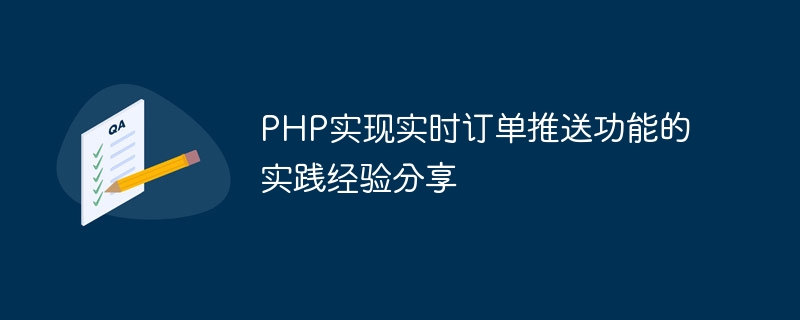

Sharing of practical experience in PHP implementing real-time order push function
With the rapid development of e-commerce, real-time order push function is very important for merchants. It can help merchants grasp the status changes of orders in a timely manner and improve processing efficiency. This article will share a practical experience in implementing real-time order push function based on PHP language and provide corresponding code examples.
1. Technology Selection
WebSocket technology is required to realize the real-time order push function. WebSocket is a protocol for full-duplex communication on a single TCP connection, which enables the server to actively push information to the client. The Swoole extension in PHP provides support for WebSocket, which can easily implement real-time push functions.
2. Server setup
First, we need to build a WebSocket server. Taking the Ubuntu system as an example, you can use the following command to install the Swoole extension:
sudo pecl install swoole
After the installation is completed, add the configuration information of the Swoole extension in the PHP configuration file:
extension=swoole.so
Next, write the WebSocket server code :
on('open', function ($server, $request) { echo "New connection: {$request->fd} "; }); $server->on('message', function ($server, $frame) { echo "Received message: {$frame->data} "; $server->push($frame->fd, "Server received: {$frame->data}"); }); $server->on('close', function ($server, $fd) { echo "Connection closed: {$fd} "; }); $server->start();
The above code creates a WebSocket server and implements the functions of monitoring client connections, receiving messages, sending messages, and disconnecting. You can start the WebSocket server by running this script:
php server.php
3. Order update push
In actual applications, the update of order status needs to trigger a push operation. In order to simulate the order update process, we can use a timer to push messages to the client at regular intervals.
connections as $fd) { $server->push($fd, $message); } } // 模拟订单更新,定时每隔10秒推送消息 swoole_timer_tick(10000, function ($timerId) use ($server) { pushMessageToClients($server); });
The above code defines a timer that triggers a push operation every 10 seconds. In thepushMessageToClientsfunction, the pushed message content can be constructed according to actual needs. In this example, we simulate order creation and push a new order message to all connected clients.
4. Client receiving push
The client needs to establish a WebSocket connection and implement message reception and processing to the server. The following is a simple JavaScript client sample code:
In the above code, we create a WebSocket object and receive messages pushed by the server through thews.onmessageevent handling function.
5. Summary
This article shares the practical experience of implementing real-time order push function based on PHP language. By using Swoole extension and WebSocket technology, the real-time order push function can be easily implemented. In practical applications, the content and conditions of pushed messages can be customized according to business needs. To improve performance and scalability, consider using technologies such as message queues to handle push operations.
Code examples and steps are for reference only. Actual applications may require appropriate modifications and adjustments based on specific business scenarios. I hope this article can provide some help and guidance for PHP developers to implement the real-time order push function.
The above is the detailed content of Sharing of practical experience in implementing real-time order push function in PHP. For more information, please follow other related articles on the PHP Chinese website!